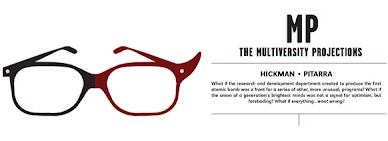
Welcome to The Multiversity Projections, our monthly column focused on the Image Comics series “The Manhattan Projects” from Jonathan Hickman and Nick Pitarra. Each month, we’ll be taking a look at the most current issue of the series and comparing notes from actual history and the alternate version presented in the book, and trying to use actual historical data to predict where the series is going next. This is a spoiler-heavy column, so if you have not yet read the most current issue of “The Manhattan Projects”, be warned that many major plot points will be discussed.
The column logo is designed by the incredible Tim Daniel, whose work can be found here.
This month is a special double-shot, as I took March off to tend to other site business, but I am back, baby! We also have contributions from series writer Jonathan Hickman, and both artists featured here, #10’s Ryan Browne and #11’s Nick Pitarra!
Disclaimer: I am not an expert in either science or World War II history; all of the information I will be using in this column is either easily found on the internet or is purely my opinion.
If you’ve been granted security clearance, read on for your briefing.
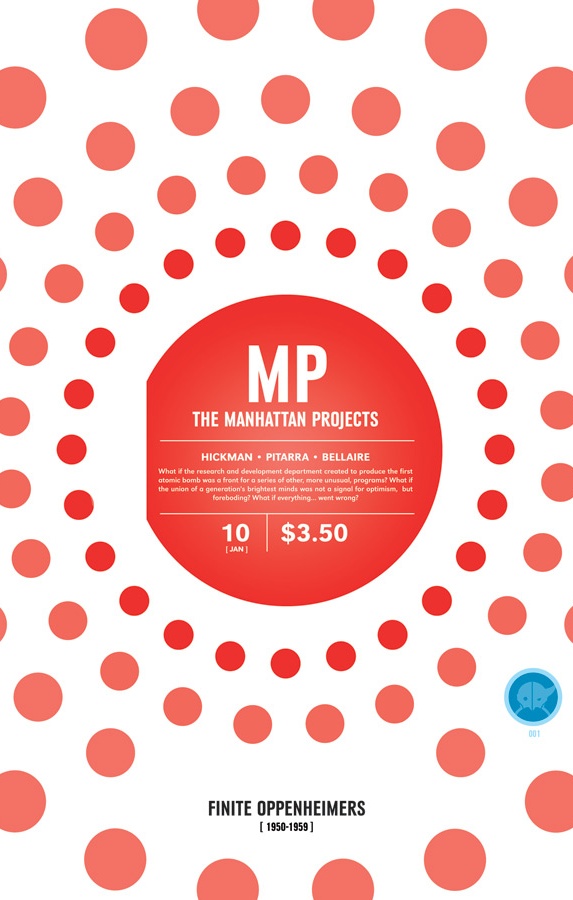
This is the first issue to take place completely away from the main action, and the sabbatical is a pleasant one. Here, Hickman and guest artist Ryan Browne (“God Hates Astronauts,” “Blast Furnace,” the new artist on “Bedlam” starting with issue #7) take a journey inside the mind of Joseph Oppenheimer, through the experience of his brother, Robert.
“Clavis Aurea: the Recorded Feynman” is excerpted three times per issue. The Golden Key (the English translation of the book’s title) deals with those quotes. This month, we only get three quotes not from Feynman, but from Oppenheimer (billed just as Oppenheimer, not Joseph or Robert).
“The great eye of Joseph watched over them all. This is how the war began.”
This quote sets the tone for the issue, which is all about change in the head of Joseph Oppenheimer. Until Robert arrives, his head is a violent, weird, fucked up place. Once Robert gets there, it is a violent, weird, fucked up place fighting itself.

The biggest shock while reading this issue is that Joseph’s theory that, if he consumes his brother completely, his soul will live forever within him turns out to be correct. The issue begins with Robert gaining consciousness inside Joseph’s brain, and seemingly having control over not just himself, but also of the entire plane of existence he finds himself in. He thinks of a fist growing from the ground, and it happens.

After wandering along the landscape for a bit, Robert finds the city that is the nerve center of the whole land – literally, his brother’s brain or, as Hickman hilariously and eloquently puts it, “the brain of Oppenheimer Prime.”
“The great eye of Joseph watched over them all. This is how the war was lost.”
This quote is a tricky one, as every war is won and lost, depending on the perspective. Is this quote announcing that Robert’s blue-hued “good” guys lost to Joseph’s red army? Or, was the war lost for the home team, and Robert was successful?
The first projections of Joseph that we meet are a horse that Robert tames by biting its ear off, and four dead Oppenheimers, hung in effigy, in the archway that leads to the city.

Shortly after this, Robert must battle the “Watcher-assassin” that guards the city – and once he does, he can enter the city safely.
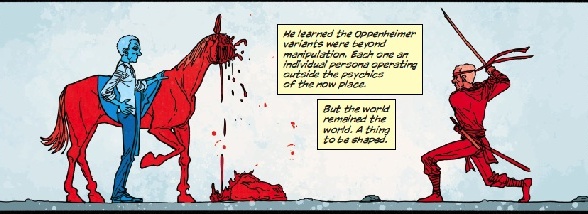
What Robert finds there reminded me of one of my favorite scenes in cinematic history: the moment when John Malkovich goes through his own portal in “Being John Malkovich.” Instead of “Malkovich,” everyone in Joseph’s brain says “Hmmmmm.” We get some amazingly great Oppenheimer clones here, as Robert explains that every thought Joseph had became reality. So, we get a glimpse into Robert’s twisted mind: what if I was a redneck? What if I was a skier? What if I was making out with a biker version of myself?
Continued below
As stated earlier, this month features art from Ryan Browne, who is an amazing artist (don’t believe me? Check out this insane Abe Sapien he did for us last month!) and a great visual storyteller. You’ve been seeing his great work all throughout here, but here is a panel that struck me as everything great about Browne’s work – it is beautiful, detailed, heartbreaking and funny all at once:
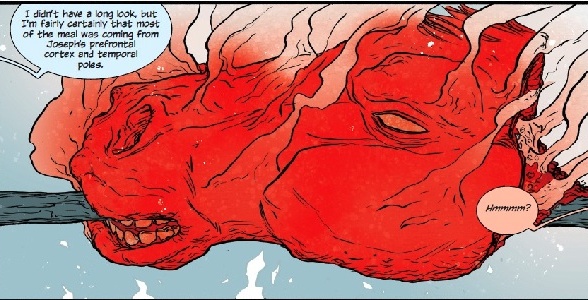
Robert plucks out the eyes of the “Watcher-assassin,” thus changing his perception of the world, and turning him blue or, in other words, to his side. It is then that Robert’s mission becomes clear: turn Joseph’s creations against him.
“We looked up, and from the mega-mid it looked down. The great eye offended, so we plucked them out. Again, and again, and again.”
This quote leads the reader to believe that the war was won by Robert and his troops, but the story still is not entirely clear. I am eagerly looking forward to the next installment of the Oppenheimer story in issue #15. How do I know it will be in #15? Keep reading…
1. Browne’s Issues Will Continue to be Cinematic in Feel
Nick Pitarra’s art is undeniably rooted in comics, whereas Browne’s have a firm footing in the cinematic (this is not an endorsement of one artist over the other; Browne’s work simply speaks to a different set of influences than Pitarra’s, which is a positive) Allusions to spaghetti westerns, Kill Bill, The Matrix Revolutions, Being John Malkovich, The Wizard of Oz and the Monkees’ Head are all here, at least to my pop-culture soaked brain. Even if these are unintentional, Browne’s art evokes a film’s atmosphere, and allows the brain to make these connections.
2. Truman
So far, we’ve seen only Oppenheimers show up in Joseph’s brain – but if you recall, he has eaten at least one other person, and that is Harry S. Truman. Will Truman wind up inside of his subconscious? Would be be on Robert’s side? Would Robert even accept his help? Does being a Freemason continue when inside someone else’s brain?
3. Eyeball Collection
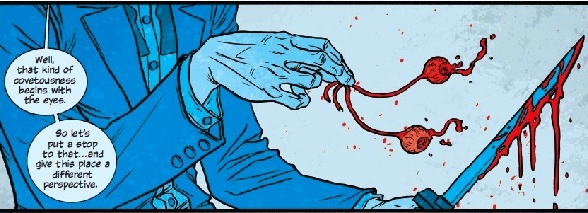
Much like Native Americans collecting scalps, or soldiers collecting ears, it appears that Robert will be the type to carry his victories with him, and hold onto the eyeballs he plucks from Oppenheimers. I can’t wait to see what sort of jewelry Robert fashions out of the eyeballs. A friendship bracelet? A belt? A braided wig?
4. Egyptian Imagery
The selection of Egyptian-style architecture in the city is an interesting one. Ancient Egypt is a land considered far ahead of its time, and that had unusual, even mysterious origins of some of its most famous images (such as the theory that aliens helped built the pyramids).
However, the pyramids represent something else as well: slave labor. The issue makes mention of non-sentient beings created to do the manual labor of the city.
To take this one step further, let’s apply some Biblical imagery to it. The Israelites who lived in Egypt in the 14th century BCE or so were used as slaves, serving the Pharaoh’s whim until Moses, an Israelite raised by Egyptians stood up for the slaves and, eventually freed them by evoking God’s wrath on the Egyptians.
Will Robert be the Moses of these slaves? Will one of their own rise up and call upon Robert the demigod, he who can create images with his mind and manipulate the landscape, to free his people?
5. Eating Yourself
The brain of Oppenheimer Prime is being feasted on by his various creations. No matter why it is being done (perhaps symbolic of the brain power it takes to create such creatures?), it can’t be good for Joseph. Perhaps, along with the assault by Robert, this is how Joseph falls – he has spread his mind too thin feeding all of his bastard children.
Continued belowFirst up, I speak to guest artist Ryan Browne about working on the book, and he was kind enough to send over some process work and his audition pin up!
BVS: So, Ryan, can you tell us a little about how you came to be doing a few issues of “The Manhattan Projects?”
RB: I met Nick Pitarra a couple of years ago when he contacted me to tell me he was a fan of God Hates Astronauts. From there we got to be really good friends and at Heroes Con last year we hung out all weekend and he introduced me to Hickman. Given Nick’s generosity and forceful attitude, he pushed my work onto Jonathan to become the fill in artist for MP. Hickman finally gave in yet he told Nick that if I screwed it up, that Nick was never choosing another artist again. No pressure, right?

BVS: What is the biggest challenge of doing such an unbelievably insular story?
RB: Well the biggest challenge for me was to keep the feel of the book as close to what Nick was doing so that the change in artist wouldn’t cause the book to lose readers—that and drawing pyramids in perspective. That was the hardest part. The funny thing is that to get the job on the book I had to do character studies of every character to make sure I could keep it on model… then I ended up only drawing Oppenheimer for two issues. The book was limited in that it was only one character, but unlimited in what Jonathan allowed me to invent and flesh out the world of Oppenheimer’s brain with.
BVS: Was it fun/frustrating/both/neither to have to draw multiple Oppenheimers? How do you approach such a challenge?
RB: It was a lot of fun, though I think by the end of drawing issue 15, my Oppenheimer is MY Oppenheimer. As I got into a groove with the character I think it gets a little off model from what Nick does so I kind of regret that. Since there was no real restriction on what Oppenheimer’s could look like, I actually threw out a question on Twitter for people to suggest different jobs and costumes. I was a fun collaboration with the fans and it helped me to come up with more fun weird ideas. My favorite thing to draw in the book was the horse and I was happy that Hickman wrote it into the script, yet unhappy when he had the ninja warrior Oppenheimer killed it. So I asked if the horse could exist without a head and Jonathan agreed—and I’m glad I did because it continues to be a character in issue 15.

Next up, I spoke to Jonathan Hickman about his first time on this book working with someone other than Nick Pitarra.
BVS: Ryan Browne stepped in this month and contributed an amazingly weird, beautiful issue. I know Browne will be stepping in for #15 as well, which leads me to my question. Will the “in between arcs” issues of the book be featuring the same sort of detours from the main story and, if so, what other sort of adventures can we expect? Or will they all take place inside Oppenheimer’s brain?
Also, if you could share a few words about working with Ryan, that would be great.
JH: Ryan will be handling all of the Oppenheimer v. Oppenheimer story for us. Right now, that’s built in to be issue 10 (which came out today), issue 15 and then, ideally, a third issue that’s farther down the line (and therefore kind of impossible to schedule right now).
So that’s a pretty well-defined plan as to what the next couple “in between arcs” issues will be. Will there be more? I would guess so. What will they be? I think if you look at how Oppenheimer was set up, you can look back at some of the things in the earlier issues and have a pretty good idea where we would go with other stories like this.
Continued belowAs for working with Ryan, I guess I would say that there are a few requirements to get to work on Manhattan Projects. You have to have an irreverent sense of humor, you have be able to create, and tell, a divergent story within the broader story, and you have to be really talented. Ryan is obviously all three, and if you want a perfect example of this, just check out his book “God Hates Astronauts.” It’s pretty damn great.
In issue #6, we are introduced to Star City, a new locale for the series, and a new cast of characters. In issue #10, we are introduced to Oppenheimer’s brain, and a whole new cast of characters that reside therein. The parallels continue!
…is now.
This issue has two conflicting themes: hope and loss. This issue is partly the story of Harry Daghlian, and how he became the irradiated man we encounter in this series. It is also partly the story of the Manhattan Projects becoming something more than any member could have ever encountered.

Only one quote appears in this issue, and that is on the final page, before the cast list.
“All hail the demon core” – Fermi
The demon core is the name of the plutonium that wound up irradiating his body. Why is Fermi declaring it a good thing? Does he see Harry as the next evolution of man? Is there a sinister tone behind his overt kindness to Harry throughout?
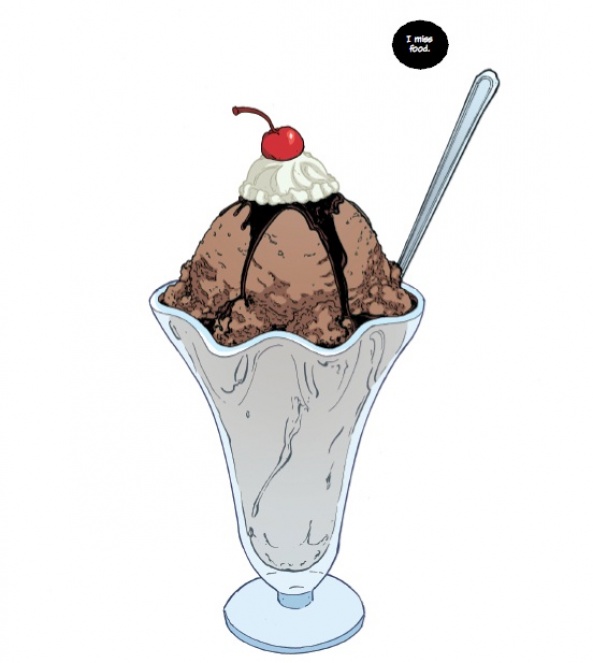
After an issue by Browne, our pal Nick Pitarra is back, bringing his incredible attention to detail back to the pages of this book. His first page back is a testament to the staggering beauty his intricate work is capable of, even when drawing something simple.

A large part of this issue is showing how Harry Daghlian became who we see month after month. He is a guy who has caused the death of an entire species (back in #5) by just existing, but beyond that, hasn’t really done anything of note. He’s been, generally, just the irradiated guy in the room.
But this issue shows him in a different light. He’s revealed to be well-liked and kind; a guy who loves food, but can’t eat it; a guy who just wants friends, but is feared by everyone. We’ve seen men abandoned in other dimensions, brothers killed and eaten, bombs dropped on entire cities, and yet the above picture of ice cream is one of the saddest things ever shown in this book.
This is a testament to Pitarra’s skill – look how an irradiated skull reading a self help book can actually look to be moping:


But he’s not entirely alone – he has his friend Enrico Fermi. Fermi is another character that has been around on the fringes of the book, but hasn’t had much revealed about him, other than that he’s an alien (which we know, but the other scientists don’t know yet).
The friendship has a sweetness to it, especially because Fermi, as an alien, isn’t as afraid of Harry as the rest are. He builds him a containment suit, he visits him, they take walks together. In a book that can be hilariously cold and violent, this is a warm, sunny spot in the book. I can’t imagine it’ll last too long.

The other half of this book is all about how the Projects have expanded past anyone’s imaginations. Their building looks like a combination shopping mall/office park but, you know, hosts the world’s most genius minds.
But the growth isn’t just physical; Oppenheimer has plans for the Projects to expand into, frankly, enormous and borderline terrifying areas. More on those in the Projections below.
This part of the book is as exciting as the Daghlian section is heartwarming. Most plots about scientists always have a stake in the question “are we going too far?” The men of the Projects don’t know what that means, and so are blowing right past “too far” and heading straight to “farther than imagined.”
Continued below
However, there is still some realism here – the space elevator that Fermi and Daghlian take to their Moon base is a relatively common scientific idea.
For an issue that is pretty touching, we still get some hilarious moments. Take this picture of JFK in the “Cast” section and its description. This made me laugh out loud so hard at work a co-worker checked in on me. Thanks, boys.

Oppenheimer, at a meeting on the moon (I love typing sentences like that), suggests three programs he wants to launch, as well as a fourth that one of his personality creations spills the beans on to the readers. I’m going to take what he says about each one, do a little research on the names, and project from there, as well as talk about Fermi’s dismissal of the programs.
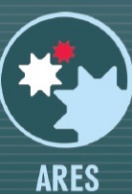
1. Ares
Ares is an “aggressive space program tasked with the goal of exploring, and colonizing, our local system,” with Mars being the first target.
This project perfectly appeases von Braun, who wants to work on “his rockets.” However, Ares is the Greek god of war, and so the name suggests that there is more than just colonization of uninhabited planets at play here.
As seen in #5, destruction of species isn’t something feared or balked at by these men, and so it shouldn’t come as a surprise that Oppenheimer would want a program to take out all of these pesky aliens.

2. Gaia
Gaia is “focused on perfecting our own biological systems” and “radically expand the human lifespan, to repair damage in the forms of disease and common injury,” with the ultimate goal of preparing our bodies for living in space.
Mythologically, Gaia is the Greek goddess of Earth; the physical personification of Earth and all of its creatures. Through her union with the god of the Sky, Uranus, she gave birth to all, even the planets and the stars.
Oppenheimer sees this as the birth of a new breed of man, able to live forever and be unharmed.

3. Vulcan
The final “public” project is Vulcan, which is a “long range energy plan,” set to “control the energy on our planet” to have unlimited financial resources to do what they wish to do.
Vulcan is the name of the Roman god of fire, including volcano fire, and was seen as responsible for fire’s good and bad qualities. Fire can destroy, it can purify, it can strengthen, it can heal, it can provide nourishment. Once man had fire, his path to the iPhone was set. Once the scientists have Vulcan, there is nothing they can’t accomplish.

4. Charon
This is the “secret” program that tattooed, Texan Oppenheimer spills about. Nothing is said about it but the name, but the name is a loaded one. Charon captains the ferry across the river Styx, from the land of the living to the dead.
Is Oppenheimer’s ultimate goal the destruction of all life? Is he so far gone that he can no longer separate megalomania from genocide?
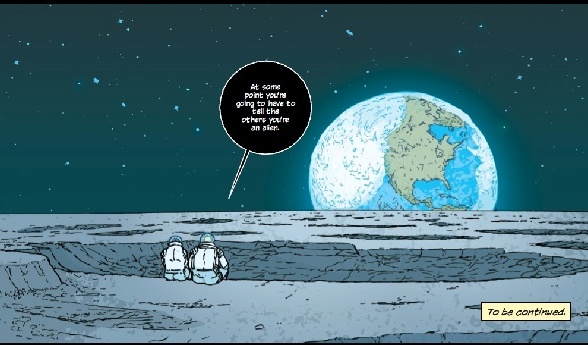
5. Fermi’s Hesitations
If the others knew about Charon, they’d be opposed to all of this, but they don’t, and so they aren’t. However, Fermi is suspicious. Why?
Well, Fermi is an alien, and he probably sees all of these plans of human domination as something as a threat to his species. Because, you know, it is. Is Fermi right? Possibly, but he isn’t right for anything but selfish reasons.
All I want to talk about is my second favorite Harry currently in any medium (just behind Harry Crane, the horniest ad man in the universe). First up is Hickman.

BVS: This month is an examination of Harry, a character that has been mostly on the periphery of the book thus far. He is a fascinating character, as he is presented as almost the everyman in the group, and yet is an irradiated skeleton inside a containment suit. This issue takes time to really humanize him and make him a very sympathetic character – it even gives him a friend, something downright rare in this story.
My question is this – why is now the time to introduce some humanity to the series? If anything, the tone of the book is getting more and more detached from the people that the characters were originally trying to protect, and yet Harry’s story tugs at the heartstrings more than any other we’ve seen so far, save maybe for poor Helmutt.
JH: Full confession, like other human types, I too am capable of emotional connections. As such, from time to time, I feel the need to express said behavior.
And while I do not condone excessive ‘feeling,’ or even believe that it is truly profitable to experience what some people might call ’empathy,’ there are times, fleeting moments actually, where I see the potential worth of dabbling. A toe in the dirty water, if you will.
And now I have to go wash this off.
On to Pitarra, who gets me this stuff minutes before I need to post it, but always gives me such great stuff I can’t stay mad at him for long.
BVS: #11 is a really sad issue, even though everything sort of works out for the best in a lot of ways. Harry gets irradiated, sure, but he’s able to survive and he has a pal in Enrico. You manage to get a healthy dose of humanity into his non-human form. What are you striving for when drawing Harry?
NP: I think the thing that first struck me about Harry…the real life Harry Daghlian… was how young and sweet he looked on his Wikipedia page. He’s kind of chubby and he has a kind smile. It’s fucked that we have him walking around as an irradiated skull in a hazmat suit…kind of sad, in the book and, of course, in real life. The guy died young.
I’ve always felt like he was the sweetest/nicest guy in The Manhattan Projects group. The one entangled with our cast of evil scientist/villains less by choice and more by the horrible accident that created him. Art wise I try and capture a sweetness to him. I keep his hazmat suit inflated and fat…making him a little less sinister. I focus on his eye sockets for emotions…its pretty easy to make him seem sad or angry just by the way I render the inside of his upper brow. All of the rest…and I try to do this with all the characters …is done through posture. Showing him depressed/confident/angry/sad/bored is shown in his spine…his line of movement.
With Harry being a skeleton, the overlapping rib cage and the fact that you can see his spine, actually helps all of that. In the end, the coolest thing about Harry in context to the team is that the nicest guy on the team is the one walking around as an irradiated skeleton. I love the idea that the one thing good in our version universe, is the embodiment of nuclear power. Versus in real life, the scientist are largely scene as good/conflicted… and they created something evil. Jon and I have flipped that … Harry is good and conflicted, the scientist are the evil ones…way worse than the nuclear power they created. Hopefully my art is doing some of the lifting in showing off these little nuisances and themes.
Here’s a page of previously unseen Harry character studies. If I’m doing my job right you can see things like Dejection, Hope , Confidence, Sadness, and even him being Stoic …all in his form and face…even though he’s only a skeleton.

Issue #7 was all about how conflict should have arisen between Star City and Los Alamos but…it didn’t. Issue #11 is about how Harry Daghlian should be dead…but isn’t. It is also about how these men should have hit some roadblocks along the way…but haven’t.
Continued belowWill the other shoe drop? Or, have these men actually figured it all out?
#12 is titled “The Fermi Paradox,” so it looks like our questions about Enrico will get answered quicker than we thought.
This was the craziest issue thus far, and with next month’s brief reprieve notwithstanding, it seems that we are on the path to even crazier times ahead.
If you have any questions, thoughts, or observations, please leave them in the comments below, or email brian@multiversitycomics.com.
You can purchase “The Manhattan Projects” at fine comic book stores everywhere, or digitally here.
See you next month!






